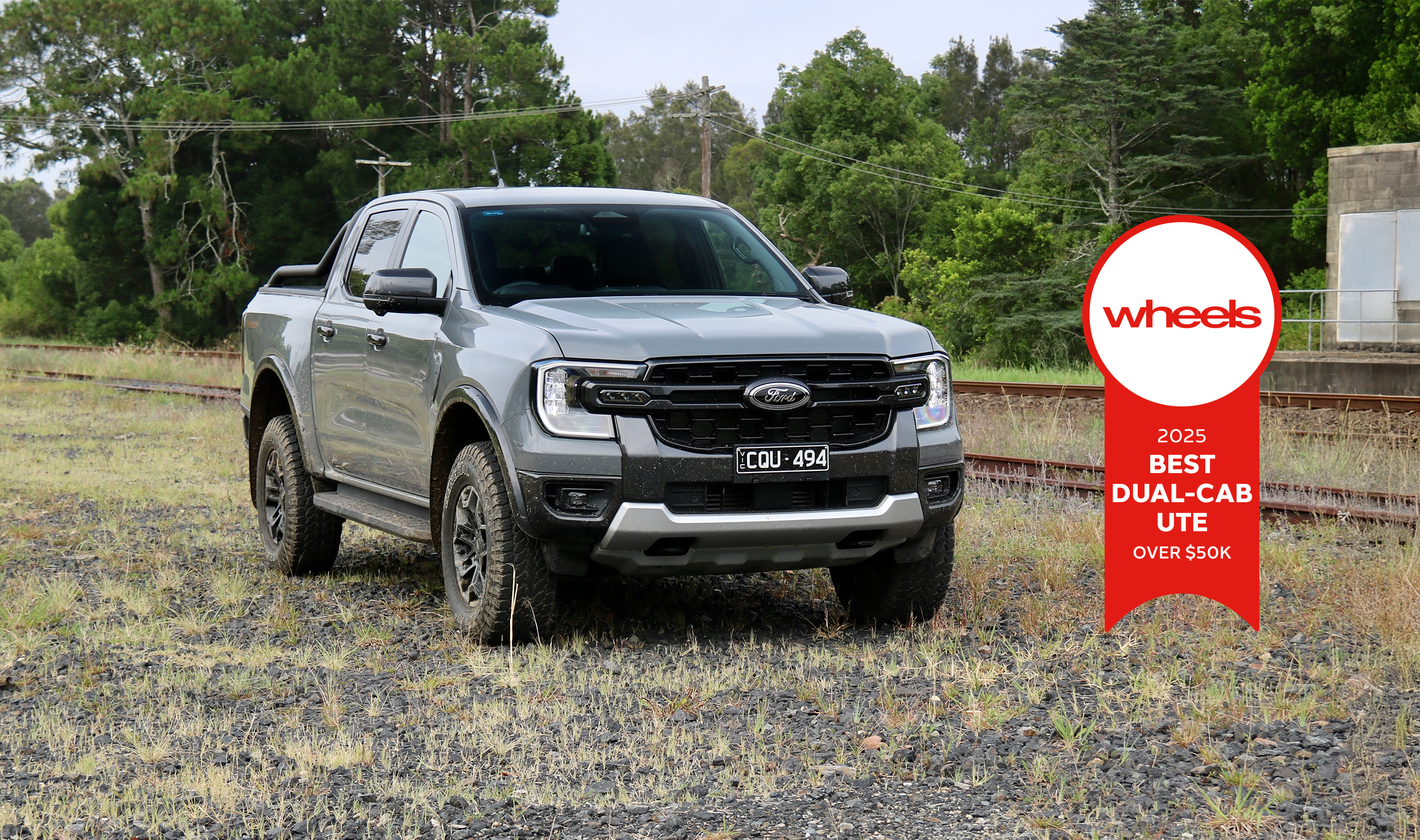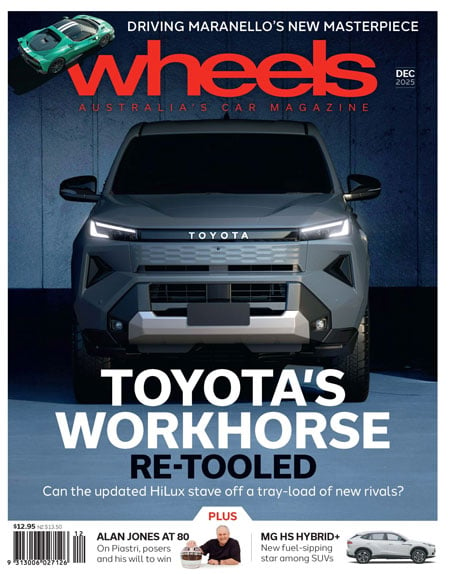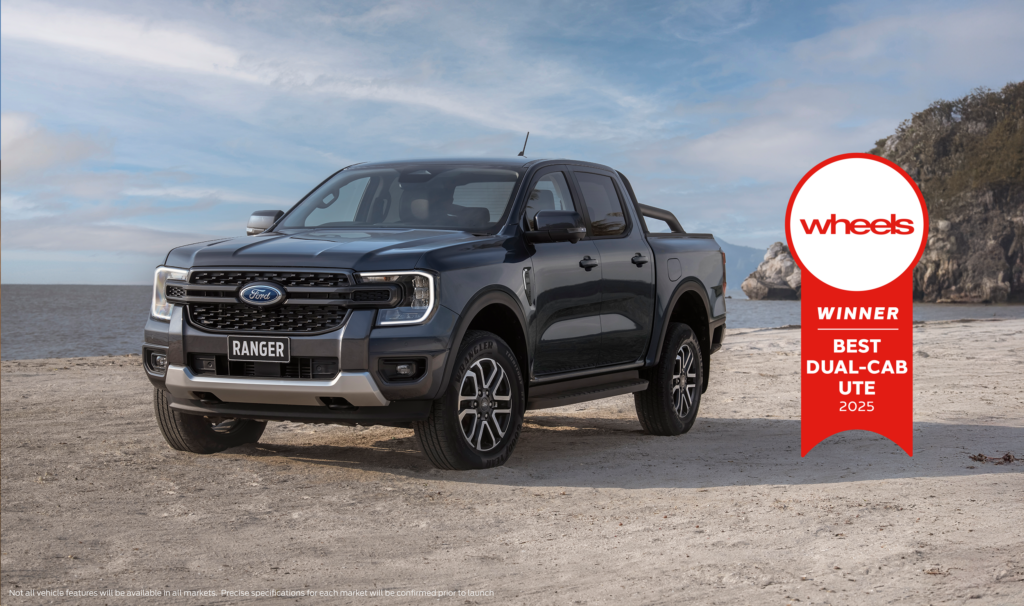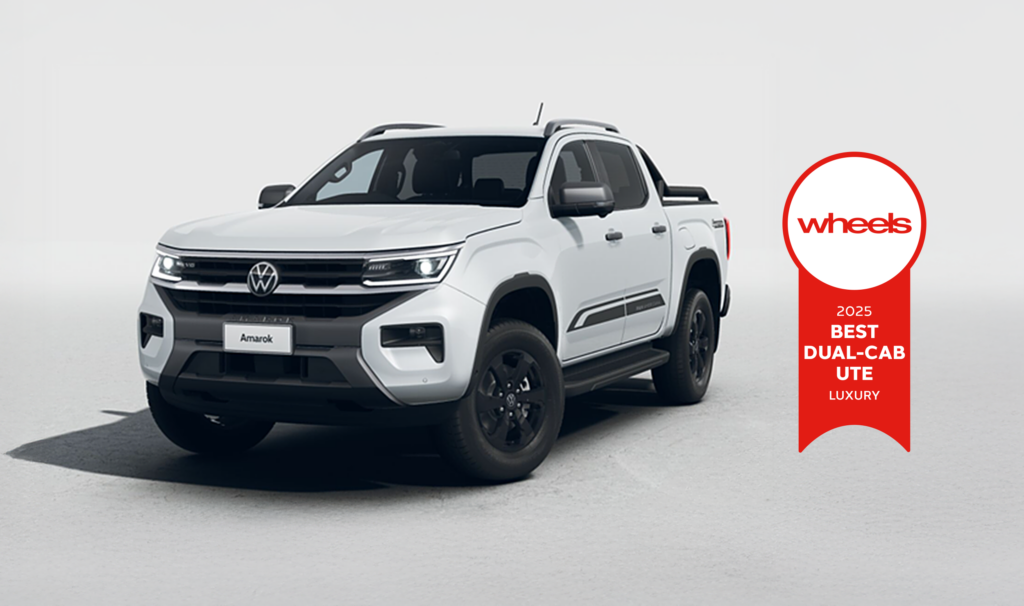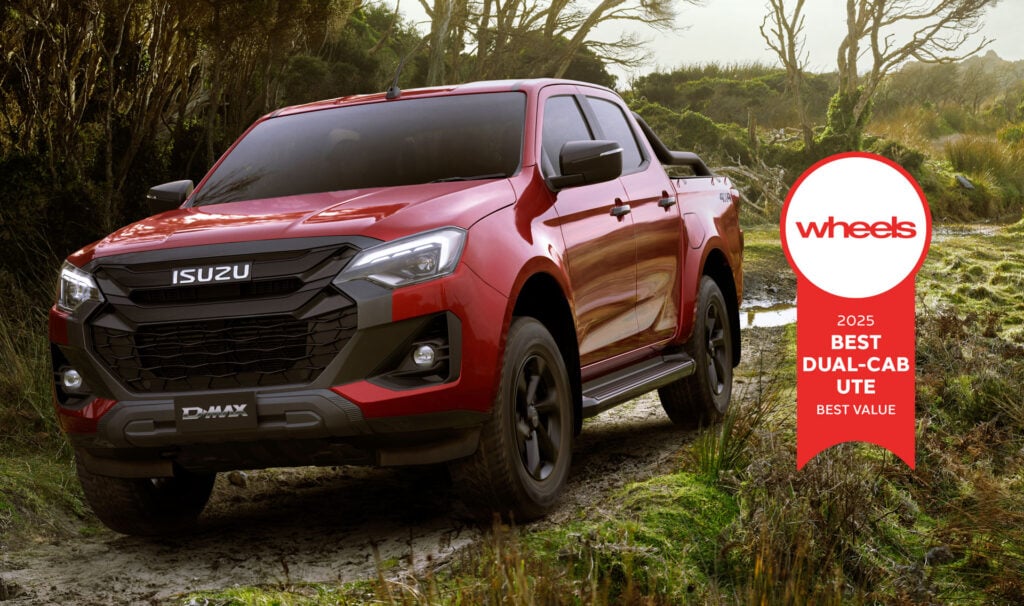Contenders
- Ford Ranger
- Mitsubishi Triton
- Isuzu D-Max
- Mazda BT-50
- VW Amarok
- Nissan Navara
- GWM Cannon Alpha
- Toyota HiLux
- Jeep Gladiator
- BYD Shark 6
- Kia Tasman
- Toyota LandCruiser 70 Series
Winner: Ford Ranger
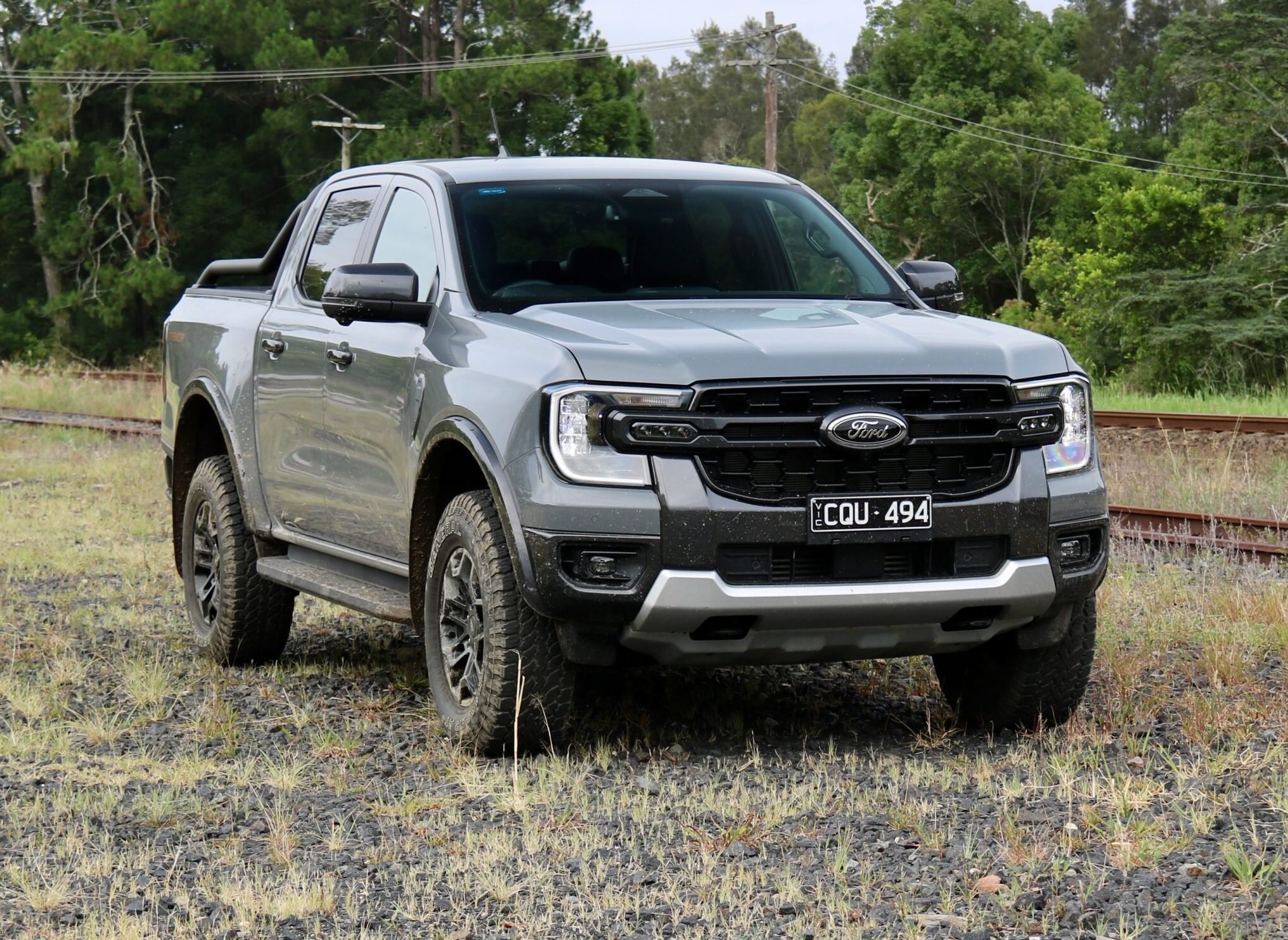
- Price: From $36,880 plus on-road costs (XL Hi-Rider 4×2 Single Cab), up to $90,440 +ORC (Raptor)
- Drivetrain/economy/CO2 emissions: 2.0L turbo-diesel: 125kW/405Nm, 6-speed auto, 2WD or 4WD, 7.6L/100km, 199g/km; 2.0L twin-turbo diesel: 154kW/500Nm, 10-speed auto, 4WD, 7.2L/100km, 189g/km; 3.0L turbo-diesel: 184kW/600Nm, 10-speed auto, 4WD, 8.4L/100km, 222g/km; 3.0L turbo-petrol (Raptor): 292kW/583Nm, 10-speed auto, 4WD, 11.5L/100km, 262g/km; 2.3L turbo-petrol PHEV: 207kW/697Nm, 10-speed auto, 2.9L/100km, 66g/km
- Dimensions: Up to 5380mm long, 1918mm wide, 1926mm tall, 3270mm long wheelbase
- Towing capacity/GVM/GCM: 2500kg -3500kg/3130kg – 3350kg/5370kg – 6400kg
- Warranty/roadside assistance/service intervals: Five-year/unlimited km, 12 months of roadside assistance with each dealer service up to seven years in total, annually/every 15,000km
- Five-year service cost: $1,516 ($303 per year)
| Driving | |
|---|---|
| Interior | |
| Practicality | |
| Overall value |
Things we like
- Easily the best ute to drive
- Wide range of variants and engines
- Intuitive and practical interior
Not so much
- No variant is particularly cheap to buy
- No more manual option
- Rear seat not huge for adults
There’s no great secret as to why the Ford Ranger has been this country’s best-selling ute over the last couple of years. Designed in Australia by Australians for Australians is its unique selling point, and that home-grown focus has paid off in spades. It’s not just here either. The Ranger is the second best-selling ute globally, is sold into over 180 markets and is the third best-selling nameplate for Ford after F-Series and Transit. Go figure.
Unlike many manufacturers who had viewed utes as lowest common denominator distress-purchases, Ford took the time to research what Aussie ute buyers wanted, understood the pride they took in their vehicles and developed a workhorse that drove well, looked good and was packed with ideas that worked in the real world.
From a core range, the popularity of the Ranger line up has allowed it to grow tendrils that start out as niche ideas, such as the specialised Raptor variant, which build a cult following in their own right. The rugged Super Duty, due next year, could well be the next to outsell Ford’s most optimistic predictions. The off-road focused Ranger Tremor version has boosted appeal for those who want more ability in the dirt without stretching to the Raptor, while the recent addition of a petrol plug-in hybrid version also broadens Ranger’s appeal.
The diesel engines remain the backbone of the range and both the 2.0-litre four and the 3.0-litre V6 have something to be said for them, although we’d gravitate towards the latter for its smarter all-wheel drive system. Teething issues with the gearbox have long since been sorted, as has an issue with oil weep around the turbocharger. There’s hardly a weak spot across the entire range, but a Sport on all-terrain tyres is probably the value sweet spot.
With strong off-road ability, 3500kg braked towing ability across the mainstream range, a whole host of smart towing and off-road tech features, heaps of choice across the line up and fresh models coming on stream, it’ll take a concerted effort from Toyota to knock the Ranger off its perch.
Mitsubishi Triton
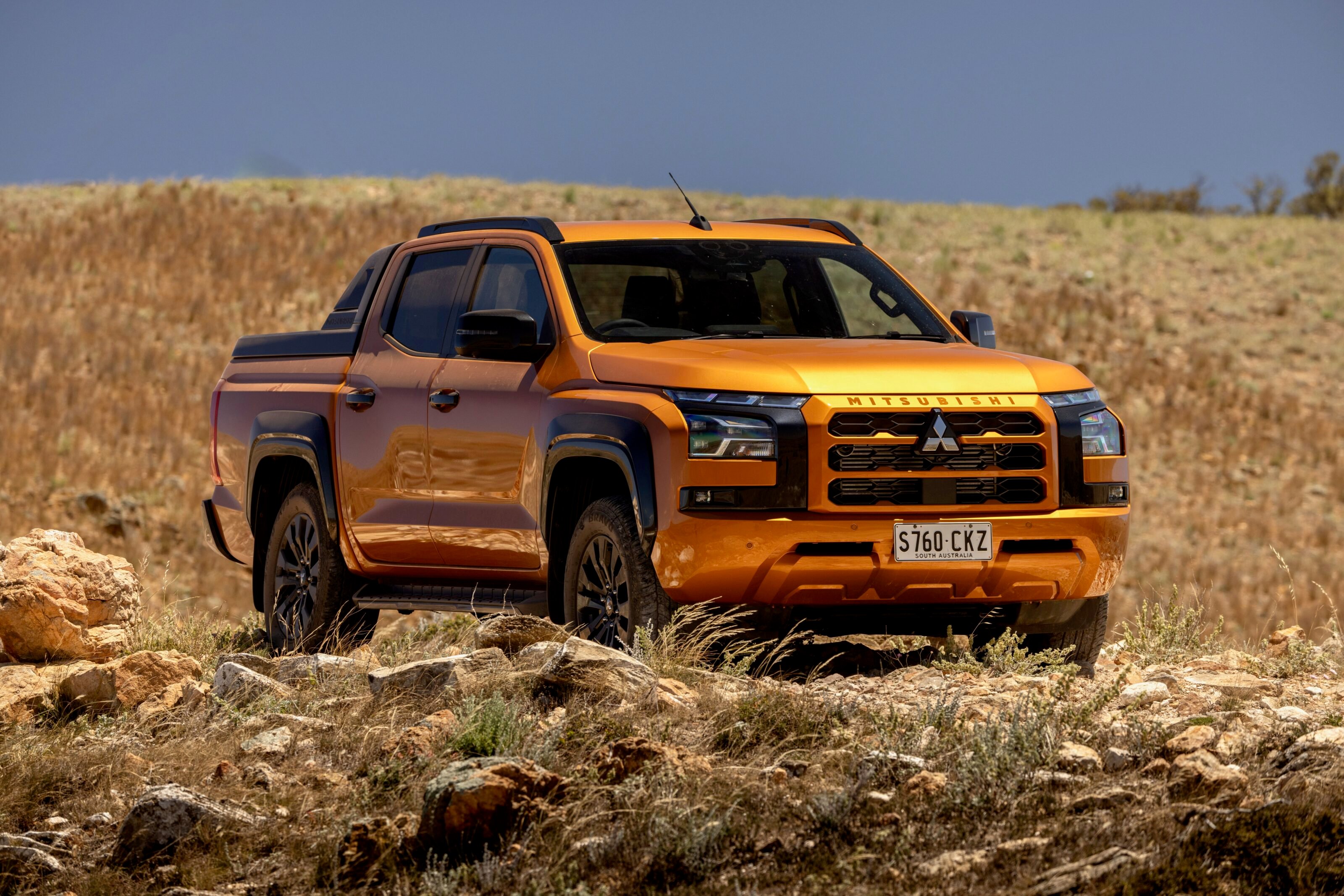
- Price: From $34,490 plus on-road costs (GLX 4×2 Single Cab manual) to $63,840 +ORC (GSR)
- Drivetrain/economy/CO2 emissions: 2.4L bi-turbo diesel: 140kW/470Nm, 6-speed manual or auto, 2WD or 4WD, 7.4-7.7L/100km, 195-203g/km
- Dimensions: Up to 5320mm long, 1865mm wide, 1795mm tall, 3130mm long wheelbase
- Towing capacity/GVM/GCM: 3500kg/3070kg – 3200kg/6210kg – 6250kg
- Warranty/roadside assistance/service intervals: Five-year/100,000km, extendable to 10-years/200,000km, 12 months of roadside assistance with each dealer service up to four years in total, annually/15,000km
- Five-year service cost: $2545 ($509 per year)
| Driving | |
|---|---|
| Interior | |
| Practicality | |
| Overall value |
Things we like
- Grunty bi-turbo diesel engine standard across the range
- Modern and practical interior
- Good refinement in the segment
Not so much
- More expensive than it used to be
- Manual only on base models
- No hybrid drivetrain yet
Released in 2024, the current shape Mitsubishi Triton received a big upgrade into its current generation. Not only was it made a lot more modern and feature-packed, but it’s also now more capable and more practical than ever before.
Under the bonnet of every Triton model is a new bi-turbo 2.4-litre four-cylinder diesel engine that outpunches rivals such as the Isuzu D-Max while also giving the Triton the industry standard 3500kg braked towing rating. On the road, the new Triton is a big improvement over the previous model, while giving a more solid road feel than some rivals. Its new engine is refined as well, especially against the loud 3.0L unit in the D-Max/BT-50 twins, though it would be great to see a plug-in hybrid variant as Mitsubishi is a pioneer in the PHEV space.
The cabin of the Triton is a massive improvement on the previous shape with better quality, more tech – a 9.0-inch touchscreen with wireless smartphone mirroring is standard across the range – and more practicality, with more rear seat space than the previous model.
While the standard warranty is a five-year/100,000km job, if it’s kept serviced at a Mitsubishi dealership after that, up to 10 years of warranty is available and its five-year service cost averages out to a reasonable $509 per year. Add in its big improvement over the previous model, its comfortable driving experience and grunty engine, and the Triton is a worthy ute option.
Isuzu D-Max
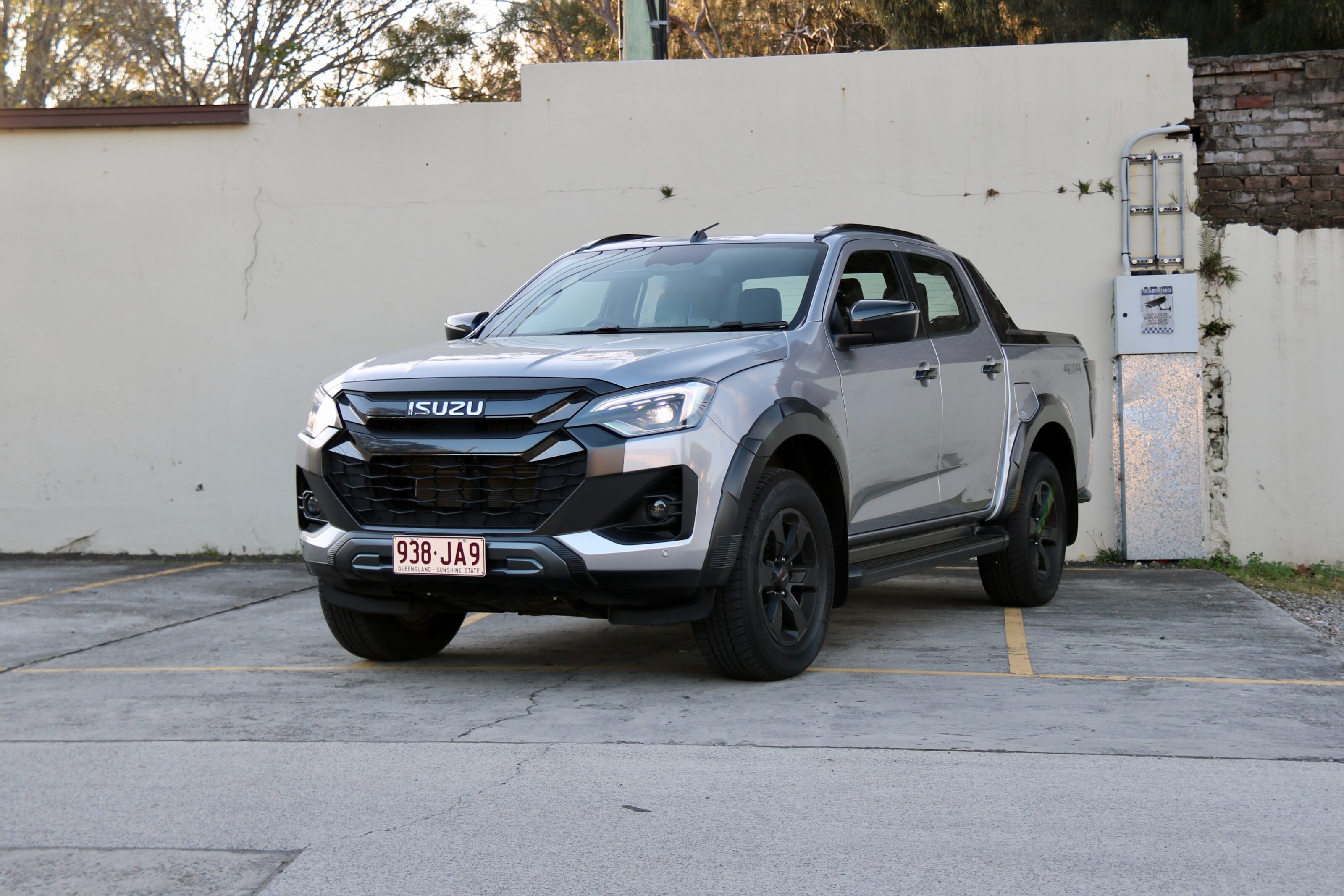
- Price: From $32,700 plus on-road costs (SX High-Ride 4×2 single cab manual) to $78,900 +ORC (Blade 4×4 dual cab auto)
- Drivetrain/economy/CO2 emissions: 1.9L turbo-diesel: 110kW/350Nm, 6-speed manual or auto, 2WD or 4WD, 6.7-7.0L/100km, 177-184g/km; 3.0L turbo diesel: 140kW/450Nm, 6-speed manual or auto, 2WD or 4WD, 8.0L/100km, 207g/km
- Dimensions: Up to 5430mm long, 1880mm wide, 1810mm tall, 3125mm long wheelbase
- Towing capacity/GVM/GCM: 2800kg -3500kg/3000kg – 3100kg/53700kg – 6000kg
- Warranty/roadside assistance/service intervals: Six-year/150,000 km, up to seven years months of roadside assistance with each dealer service, annually/every 15,000km
- Five-year service cost: $2,245 ($449 per year)
| Driving | |
|---|---|
| Interior | |
| Practicality | |
| Overall value |
Things we like
- Excellent safety equipment across the range
- Modern and feature-packed cabin
- Improved infotainment system
Not so much
- Trusty 3.0L diesel is loud
- Huge range can get confusing
- Manual only available on base SX
It’s easy to pigeonhole the Isuzu D-MAX as a crude but endearing workhorse that has built its own minor cult following. That’s to underplay the incremental development that has seen that D-MAX comfortably occupy the third spot in the Australian dual-cab ute sales charts for 2024, netting a near 12 per cent share of the market. That’s more than double the sales of the next best contenders, the Mitsubishi Triton and the Mazda BT-50. So Isuzu is clearly doing something very right.
No, the D-MAX can’t hold a candle to the Ford Ranger in terms of sophistication, but it’s not so very far off a Toyota Hilux. What’s more, it comes with a six-year warranty, although it does carry a 150,000km limit, which is something to consider if you’re cross shopping versus Toyota’s five-year, unlimited kilometre deal.
The 1.9-litre 110kW/350Nm powerplant that’s fitted to the SX Crew Cab entry-level versions should probably be given a wide berth, as for $2000 you can upgrade to the 3.0-litre with 140kW/450Nm. That’s money very well spent, as it nets you a far more flexible and relaxed engine. Because Isuzu only sells two models – this and the MU-X SUV – it keeps itself busy with a fully fleshed-out range of variants for each.
Therefore the steps from one model to the next are small and it pays to do your homework on which of the trims – SX, LS-M, X-Rider, LS-U, X-Terrain and Blade – is right for your requirements. The good-looking X-Rider Crew Cab is largely a dark-finish cosmetic pack above the LS-M grade, and will doubtless appeal to those who want a little more bling, but the LS-M is $3700 cheaper and comes with Bi-LED headlights, 17-inch alloys and higher grade cloth interior. As you ascend the range, the price tag begins to look a little more self-conscious, with the flagship $73,990 Blade being the off-road focused one, broadly adjacent to a Ranger Tremor or a Hilux Rogue.
With a thriving owner community and a wide range of accessories available, plus parts support in some of the more remote reaches of Australia, the D-MAX does a lot to appeal to those who prize capability and aren’t afraid to take their ute off the beaten track. It might not be the number one pick here, but it’ll be the first port of call for many who are looking for something that more than punches above its weight.
Mazda BT-50
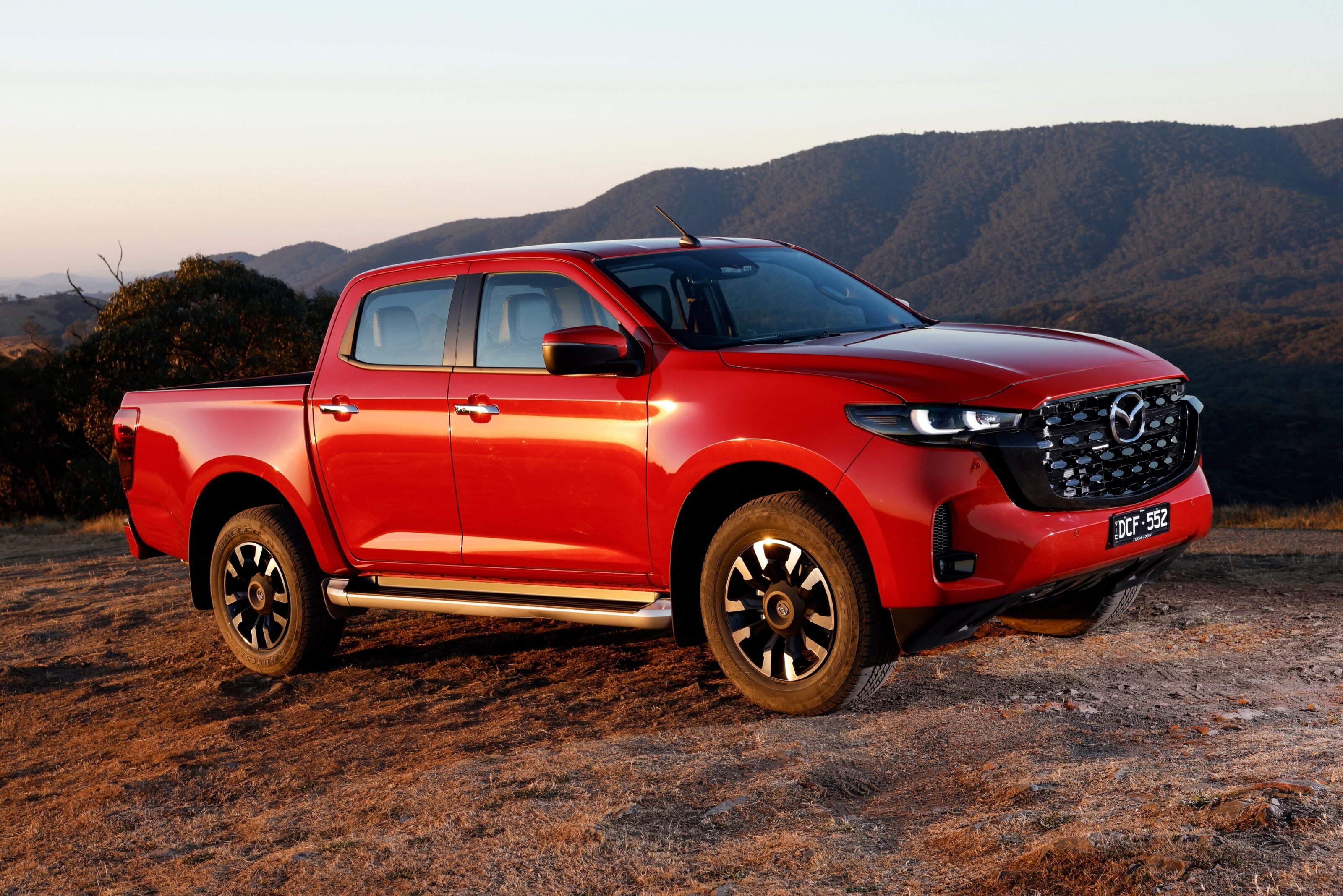
- Price: From $36,400 plus on-road costs (XS 4×2 1.9L cab chassis) to $71,500 +ORC (SP 3.0L 4×4 dual cab)
- Drivetrain/economy/CO2 emissions: 1.9L turbo-diesel: 110kW/350Nm, 6-speed auto, 4×2, 7.0L/100km, 184g/km; 3.0L turbo-diesel: 140kW/450Nm, 6-speed auto, 4×2 or 4×4, 7.7-8.0L/100km, 200-207g/km
- Dimensions: Up to 5230mm long, 1870mm wide, 1810mm tall, 3125mm long wheelbase
- Towing capacity/GVM/GCM: 3000kg -3500kg/3000kg – 3100kg/5500kg – 6000kg
- Warranty/roadside assistance/service intervals: Five-year/unlimited km, five years of roadside assistance, annually/15,000km
- Five-year service cost: $2210-$2547 ($442-$509 per year)
| Driving | |
|---|---|
| Interior | |
| Practicality | |
| Overall value |
Things we like
- Excellent safety equipment across the range
- Modern and feature-packed cabin
- Improved infotainment system
Not so much
- Loud 3.0L turbo-diesel engine
- Manual no longer available
- More grunt would be great
Shall we address the elephant in the room straight off the bat? Yes, the Mazda BT-50 is effectively an Isuzu D-MAX that has raided the dressing-up box. Mazda themselves make no great secret of that fact, and it’s easy to see why. The Isuzu bones are renowned as some of the toughest in the dual-cab division, and adding a better looking body and interior would, at first, seem to give you the best of both worlds: tough as old boots mechanicals and a level of sophistication up top.
That’s how it proves in practice too, up to a point. There’s no doubt that the BT-50 is utterly unafraid of rolling its sleeves up and getting stuck in, but where the plucky Mazda comes unstuck is in terms of overall sophistication, especially at the top of the range. When compared to the very best dual-cabs, such as the Ranger and the Amarok, were you to spend big on a BT-50, you’d soon start to suspect that you’d get a more value-dense package elsewhere.
The three-litre Isuzu four-pot engine seems – and is – unburstable, but its 140kW/450Nm is a long way shy of the numbers you’d get from a Ranger’s V6 and it’s a long way off the Ford’s measure in terms of refinement and handling too. That’s not so much of an issue if you’re spending little more than $50k on a BT-50, but dropping over $70k on a flagship BT-50 SP – which is Ranger V6 Sport money – seems like an exercise in diminishing returns.
There’s genuine reassurance in quite how strong the new BT-50 feels though. It can genuinely take a licking and still keep ticking, and it’s easy to understand how it accounts for a five percent share of the Aussie ute market. Most buyers will give the entry-level XT a skip in order to get the bigger and better screen from the XTR models up, but the introductory pricing that initially looked so attractive has ended, adding an irksome few grand to what looked like a decent value ute.
Mazda probably needed to come with more if it wanted to establish itself as a clear third option in Australia’s ute market, but what it has offered is well worth your time. If you want a properly rugged ute but don’t want your neighbours suspecting that you skin and eat all of your protein intake, the BT-50 is as good a pick as any.
VW Amarok
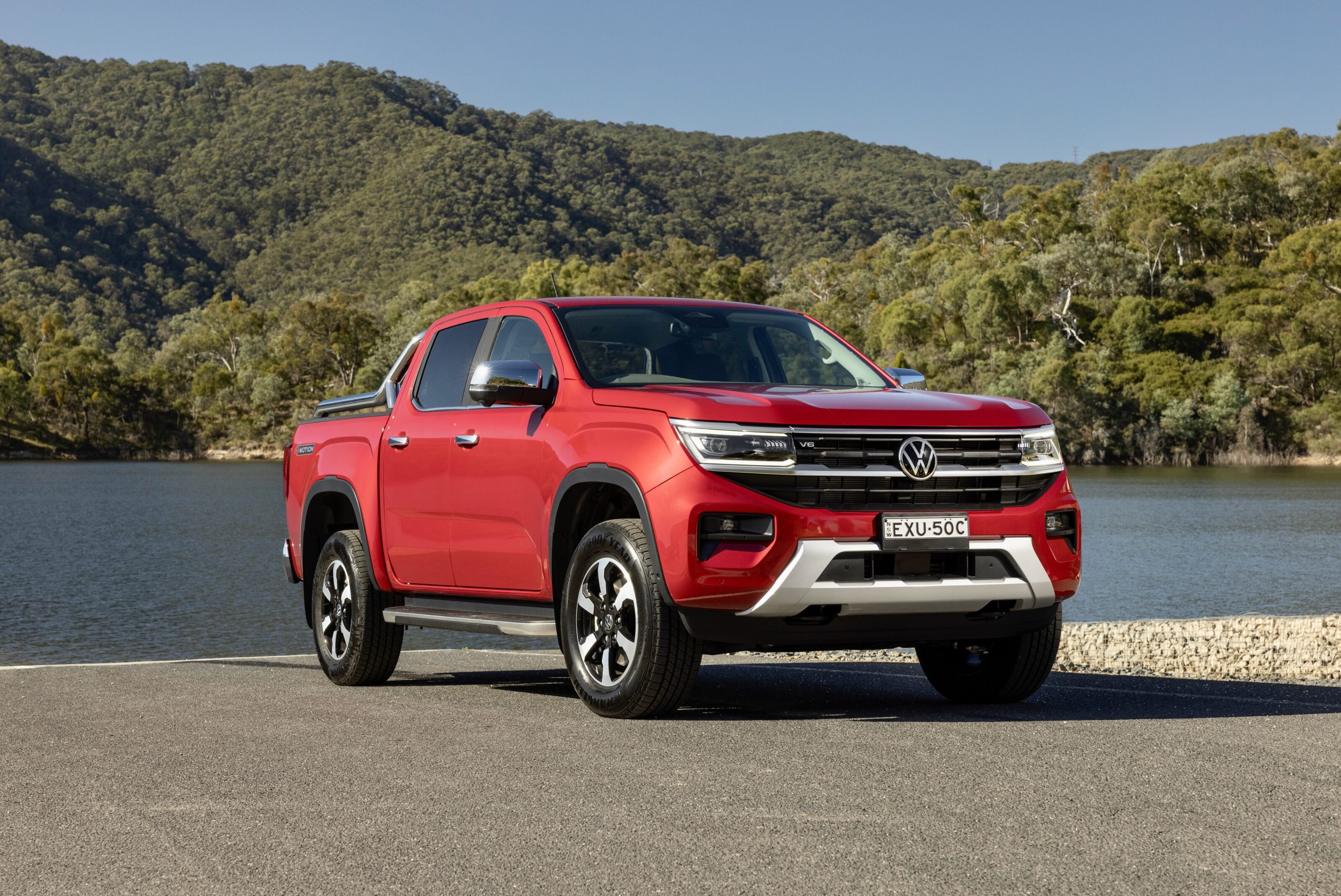
- Price: From $54,490 plus on-road costs (TDI405 Core) to $82,990 +ORC (Aventura)
- Drivetrain/economy/CO2 emissions: 2.0L turbo-diesel: 125kW/405Nm, 6-speed auto, 4WD, 8.0L/100km, 211g/km; 2.0L twin-turbo diesel: 154kW/500Nm, 10-speed auto, 4WD, 7.2L/100km, 189g/km; 3.0L turbo-diesel: 184kW/600Nm, 10-speed auto, 4WD, 8.4L/100km, 222g/km; 2.3L turbo-petrol: 222kW/452Nm, 10-speed auto, 4WD, 9.7L/100km, 222g/km
- Dimensions: Up to 5362mm long, 1917mm wide, 1884mm tall, 3270mm long wheelbase
- Towing capacity/GVM/GCM: 3500kg/3230kg – 3350kg/6200kg – 6400kg
- Warranty/roadside assistance/service intervals: Five-year/unlimited km, 12 months of roadside assistance extended with each dealer service, annual/every 15,000km
- Five-year service cost: $1900 ($380 per year)
| Driving | |
|---|---|
| Interior | |
| Practicality | |
| Overall value |
Things we like
- Great to drive, punchy engines – including hot hatch-like TSI452
- Simple model range: dual cab and 4WD across the range
- Best in class cabin quality
Not so much
- No more manual option
- Rear seat not huge for adults
- No plug-in hybrid or single cab
If you’re a little less price-sensitive when it comes to choosing a dual-cab ute, it becomes genuinely difficult to make a case against the Volkswagen Amarok. It’s an astonishingly polished package that is one of the most aspirational choices in the entire sector. But does that mean it’s a ute for people who don’t really like utes?
Not really. While there might be other choices that would be your go-to if your weekend fun involved mud ruts so deep that your diff does a decent impression of a ploughshare, the Amarok is nevertheless a lot more versatile than its sophisticated look and feel initially suggests. Under the skin, it’s much the same as the existing Ford Ranger, so it’s clearly a well-engineered package that’s designed specifically with Australian conditions front and centre of mind.
Buyers largely choose from the 125kW 2.0-litre turbodiesel TDI405 models, the 150kW 2.0-litre twin-turbodiesel TDI500 variants or the V6 turbodiesel TDI600 models, but where the Amarok has offered a key point of difference over its cousin with the Blue Oval badge is that it also offers the 2.3-litre petrol TSI452 powerplant. If you’re dead set against diesel but want these underpinnings, the $79,990 TSI452 Aventura was – hulking Ranger Raptor aside – the only show in town, but the addition of this engine with plug-in hybrid boost to the Ford’s range erodes Volkswagen’s USP here.
No great issue. The Amarok is still a better looking thing than the Ranger, with a nicer interior and the price step up isn’t perhaps as great as you might expect, with around $2k separating the entry-level Ford and Volkswagen V6 variants. That’s a relatively modest sum to apply some creative man-maths to.
Downsides? There are fewer physical controls for the air conditioning than the Ranger gets, with most of the functions incorporated into the reskinned infotainment system. You also don’t get an app to allow for the likes of remote monitoring, diagnostics, vehicle locating or over-the-air updating.
There is a feel-good quality to the Amarok that Volkswagen does very well. Choose, say, a mid-range Style version and it features leather-effect inserts on the dash and door cards and grippy microfibre ‘ArtVelour’ seating upholstery. It even gets matrix LED headlights, which you’ll value on those late drives home on country roads.
The Amarok makes all kinds of sense if you need a ute, but don’t want to shoulder many of the downsides that come with ute ownership. If you don’t think driving a ute means putting up with crude controls, second-rate interior materials and a poor ride, it makes a compelling case.
Nissan Navara
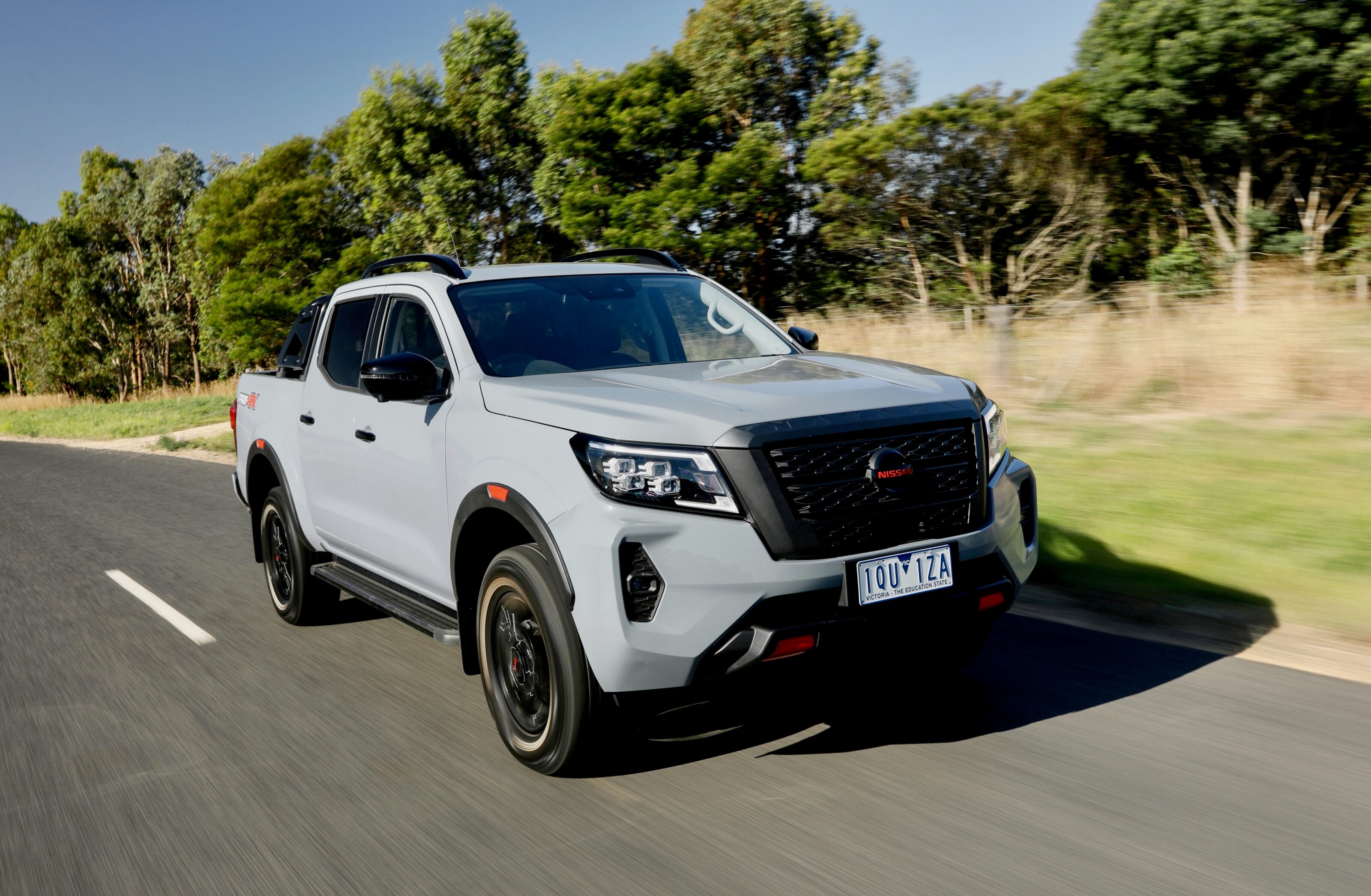
- Price: From $36,428 plus on-road costs (SL 4×2 cab chassis) to $71,643 +ORC (Warrior)
- Drivetrain/economy/CO2 emissions: 2.3L twin-turbo diesel: 140kW/450Nm, 6-speed manual or 7-speed auto, 2WD or 4WD, 7.3-8.1L/100km, 192-213g/km
- Dimensions: Up to 5311mm long, 1850mm wide, 1855mm tall, 3150mm long wheelbase
- Towing capacity/GVM/GCM: 3500kg/2190kg – 3150kg/5910kg
- Warranty/roadside assistance/service intervals: Five-year/unlimited km, up to 10 years/300,000km warranty with dealer servicing, 12 months of roadside assistance that can be extended to 10 years/300,000km with every dealer service, annual/every 20,000km
- Five-year service cost: $2495 ($499 per year)
| Driving | |
|---|---|
| Interior | |
| Practicality | |
| Overall value |
Things we like
- Most comfortable ride in the segment thanks to IRS
- Punchy twin-turbo engine standard across the range
- Very capable and Aussie-developed Warrior
Not so much
- Lacking features such as adaptive cruise control
- No hybrid or faster model
- Feeling old
One of the oldest utes in the segment, the Nissan Navara is set to gain a new generation in 2026. But we think there’s still merit in the current model, which Nissan has kept nicely updated across its lifecycle. The barebones of the Navara are impressive too, with a refined feel that outshone many rivals at its release – the independent rear suspension, for example, makes it more comfortable than a lot of competitors.
Under the bonnet of the Navara range is a twin-turbocharged 2.3-litre four-cylinder turbo-diesel engine that makes solid outputs – the same as a 3.0-litre D-Max but with 700cc less capacity for better fuel consumption – and both a six-speed manual and a seven-speed automatic are available across the range.
Like the Triton, the Navara has up to 10 years of warranty if serviced through a Nissan dealership – but it extends to 100,000km more than the Mitsubishi, and its roadside assistance can last for up to 10 years in total as well. Its $499 annual service for the first five years is reasonable in the segment, while its 20,000km annual service intervals are long as well.
While the Navara misses out on features such as adaptive cruise control and wireless smartphone mirroring, it’s otherwise still well equipped across the range and potential buyers have a heap of variantsto choose from, including the excellent Warrior by Premcar, with its off-road features made and fitted in Australia. Overall, while the Navara might be feeling a little old, it still has a lot to offer ute buyers including a potentially long warranty, grunty engine, solid driving dynamics and unique variants, like the off-road Warrior.
GWM Cannon Alpha
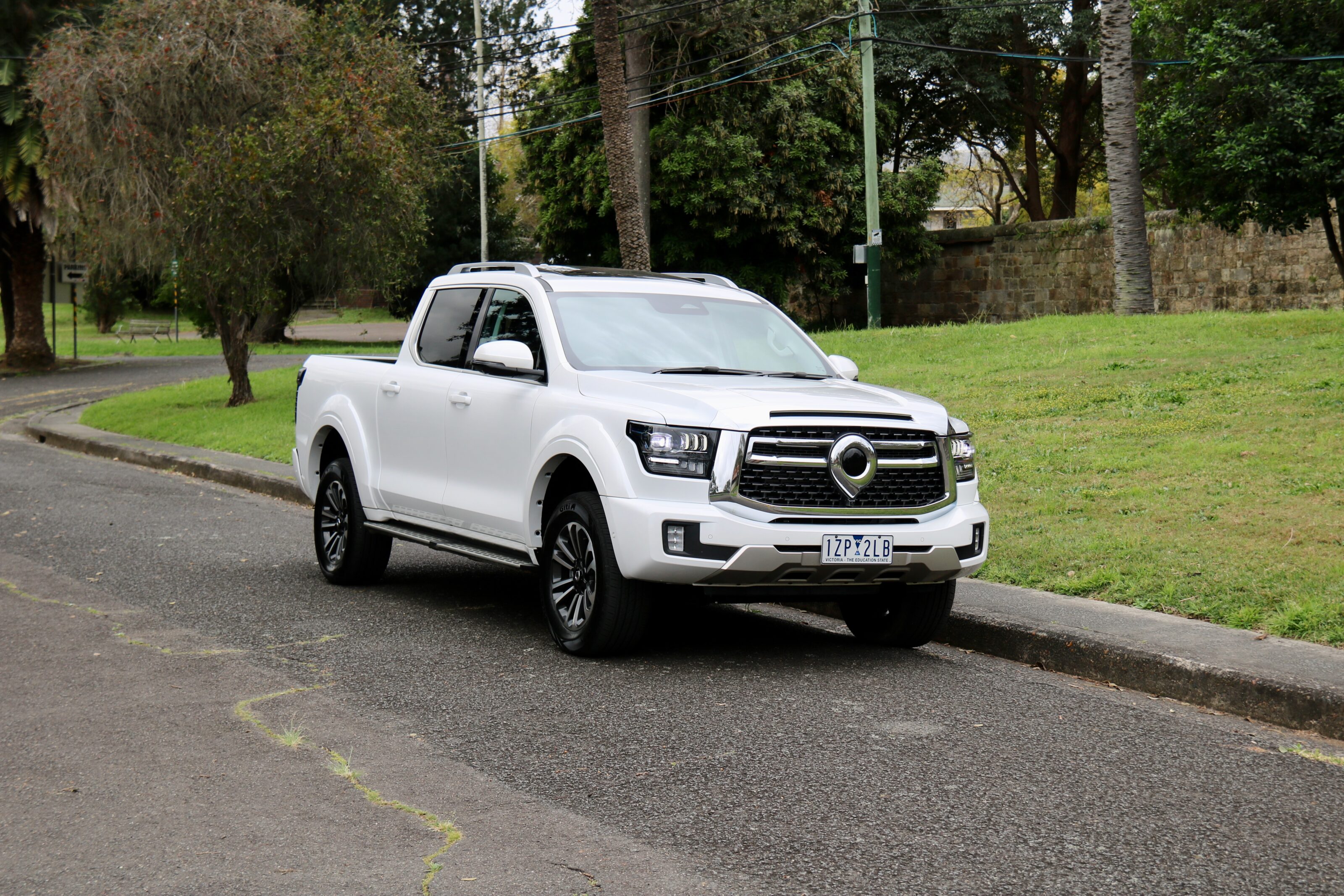
- Price: From $51,990 drive away (Lux) to $69,490 drive away (Ultra PHEV)
- Drivetrain/economy/CO2 emissions: 2.4L turbo-diesel: 135kW/480Nm, 9-speed auto, 4WD, 8.9L/100km, 234g/km; 2.0L turbo-petrol hybrid: 255kW/648Nm, 9-speed auto, 4WD, 9.8L/100km, 225g/km; 2.0L turbo-petrol plug-in hybrid: 300kW/750Nm, 9-speed auto, 4WD, 1.7L/100km, 39g/km
- Dimensions: Up to 5445mm long, 1991mm wide, 1924mm tall, 3350mm long wheelbase
- Towing capacity/GVM/GCM: 3500kg/3310kg – 3495kg/6555kg – 6745kg
- Warranty/roadside assistance/service intervals: Seven-year/unlimited km, eight-year/unlimited km battery warranty, five years of roadside assistance, six-month/first 5000km and then every year/10,000km afterwards (diesel), yearly/first 10,000km and then every 15,000km afterwards (hybrids)
- Five-year service cost: $3575-$4320 ($715-$864 per year)
| Driving | |
|---|---|
| Interior | |
| Practicality | |
| Overall value |
Things we like
- A curious entrant between mid- and full-sized utes
- Diesel, hybrid and plug-in hybrid drivetrains on offer
- Borderline luxurious interior
Not so much
- Strange and expensive service schedule
- No base hybrid variant
- Annoying active safety features
Sitting above the Cannon in the line-up, the GWM Cannon Alpha is a unique entry into the ute segment. While it’s not as large as something like a Ford F-150, it eclipses utes like its Cannon sibling to sit in a mid-way segment between the two. It’s also fairly unique not only in the ute segment but the car industry as a whole by offering two turbo-petrol hybrid drivetrains, as well as the 2.4-litre turbo-diesel that was recently installed into the Cannon.
While some buyers will choose the 135kW/480Nm 2.4-litre turbo engine, many are predicted to choose from one of two 2.0-litre turbo-petrol hybrids: either the 255kW/648Nm regular hybrid, or the 300kW/750Nm plug-in hybrid, the later of which gives a huge 115km of electric-only range and, if charged, a claimed 1.7L/100km fuel consumption rating.
Inside the Cannon Alpha is an impressively lux-feeling cabin for the ute segment, with elevated touches such as electric-reclining rear seats in the Ultra. The dashboard uses many software touch materials, while its huge 14.6-inch touchscreen controls most of the functions inside the cabin and that can be annoying.
Like the smaller Cannon, the Cannon Alpha is covered by a seven-year/unlimited km warranty and a strange servicing schedule. It’s also surprisingly expensive to service at over $700 per year. But overall, the GWM Cannon Alpha’s value equation is excellent, especially if you’ll be carrying bigger people in the rear seat. That it offers not one, but two hybrid options is impressive as well and all variants can tow a 3500kg braked trailer.
Toyota HiLux
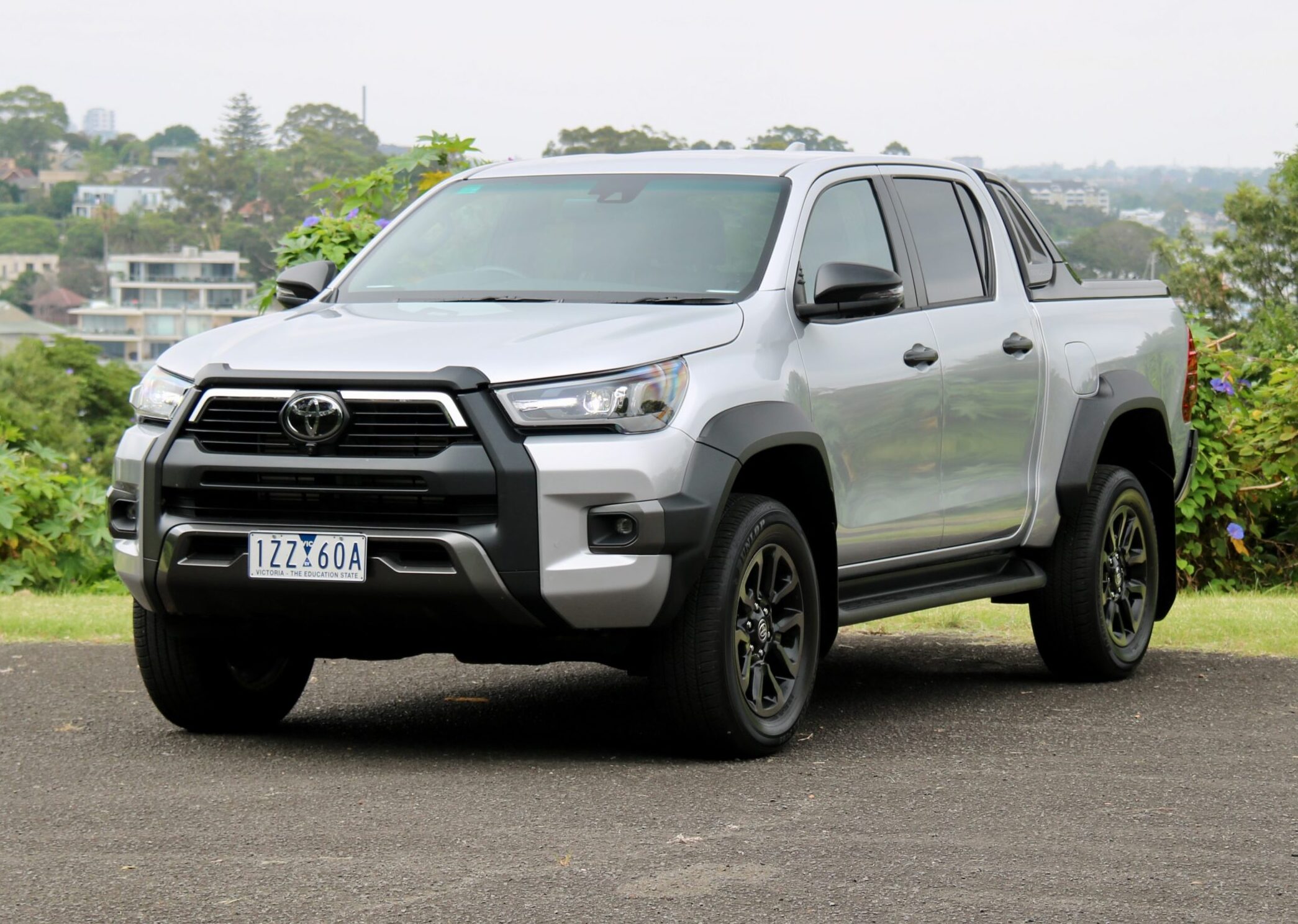
- Price: From $27,730 plus on-road costs (Workmate 4×2 Single Cab) to $74,310 +ORC (GR Sport)
- Drivetrain/economy/CO2 emissions: 2.7L petrol: 122kW/245Nm, 5-speed manual or 6-speed auto, 2WD, 10.4-11.1L/100km, 241-259g/km; 2.4L turbo diesel: 110kW/400Nm, 6-speed manual or auto, 2WD or 4WD, 7.5-8.0L/100km, 196g-211/km; 2.8L turbo-diesel: 150kW/500Nm, 6-speed manual or speed auto, 2WD or 4WD, 7.5L-8.1/100km, 197-213g/km
- Dimensions: Up to 5325mm long, 2020mm wide, 1880mm tall, 3085mm long wheelbase
- Towing capacity/GVM/GCM: 2500kg -3500kg/2700kg – 3100kg/5200kg – 5850kg
- Warranty/roadside assistance/service intervals: Five-year/unlimited km, no roadside assistance, twice annually/every 10,000km
- Five-year service cost: $3537-$4073 ($707-$814 annually)
| Driving | |
|---|---|
| Interior | |
| Practicality | |
| Overall value |
Things we like
- Wide range of variants
- Gutsy 2.8L diesel engine
- Well equipped
Not so much
- Loud engine options
- Feeling dated inside
- Base Workmate petrol very thirsty
A couple of years ago, we ran a test that pitched the Toyota HiLux against the Ford Ranger and Volkswagen Amarok. It probably won’t surprise you to hear that the Hilux finished a distant third. It felt a generation behind the others in virtually every regard and while an update has since been visited upon the venerable Toyota, the result would be the same today. But there was something telling at the wrap-up of that test.
As we prepared to depart, I asked our most experienced off-road tester which of the three he’d take if he wanted to get to Finke, or Cameron Corner, or a leisurely jaunt to Cape York. He pointed at the Hilux, snorted and said, “Not even a question.” And there, wrapped up in that appraisal, is the reason that Hilux sales have stayed so buoyant.
We can talk about infotainment systems, ride quality or interior materials all we want, but for many Aussies, it’s a HiLux or nothing. Parts are plentiful, they know what they’re going to get and, for a good proportion of these buyers, they’re on first name terms with the dealer down the road. The roots go deep here.
The current HiLux range benefits from 48v mild hybrid tech from SR trim upwards, but prices have crept up as a result. An SR5 with an automatic ‘box now retails at over $63k. Refreshingly, Toyota still offers a decent selection of manual models for those who prefer three pedals and a stick. The GR Sport version ekes another 15kW and 50Nm from the 2.8-litre turbodiesel four that is good for 150kW/500Nm in the rest of the range.
There’s little in the way of extraneous gear that can go wrong fitted to the current HiLux, although the addition of a damper for the tailgate (finally) is a welcome touch. Central locking for the tailgate? Don’t push your luck.
You’ll put up with heavy steering, an unsettled ride, poor quality cameras and an unrefined engine in order to feel at ease behind the vehicle that’s billed as ‘The Unbreakable Legend’. What’s more, with Toyota shelving plans for a new model based on TNGA-F underpinnings, the HiLux may well have to trade on that reputation for some time yet.
Jeep Gladiator
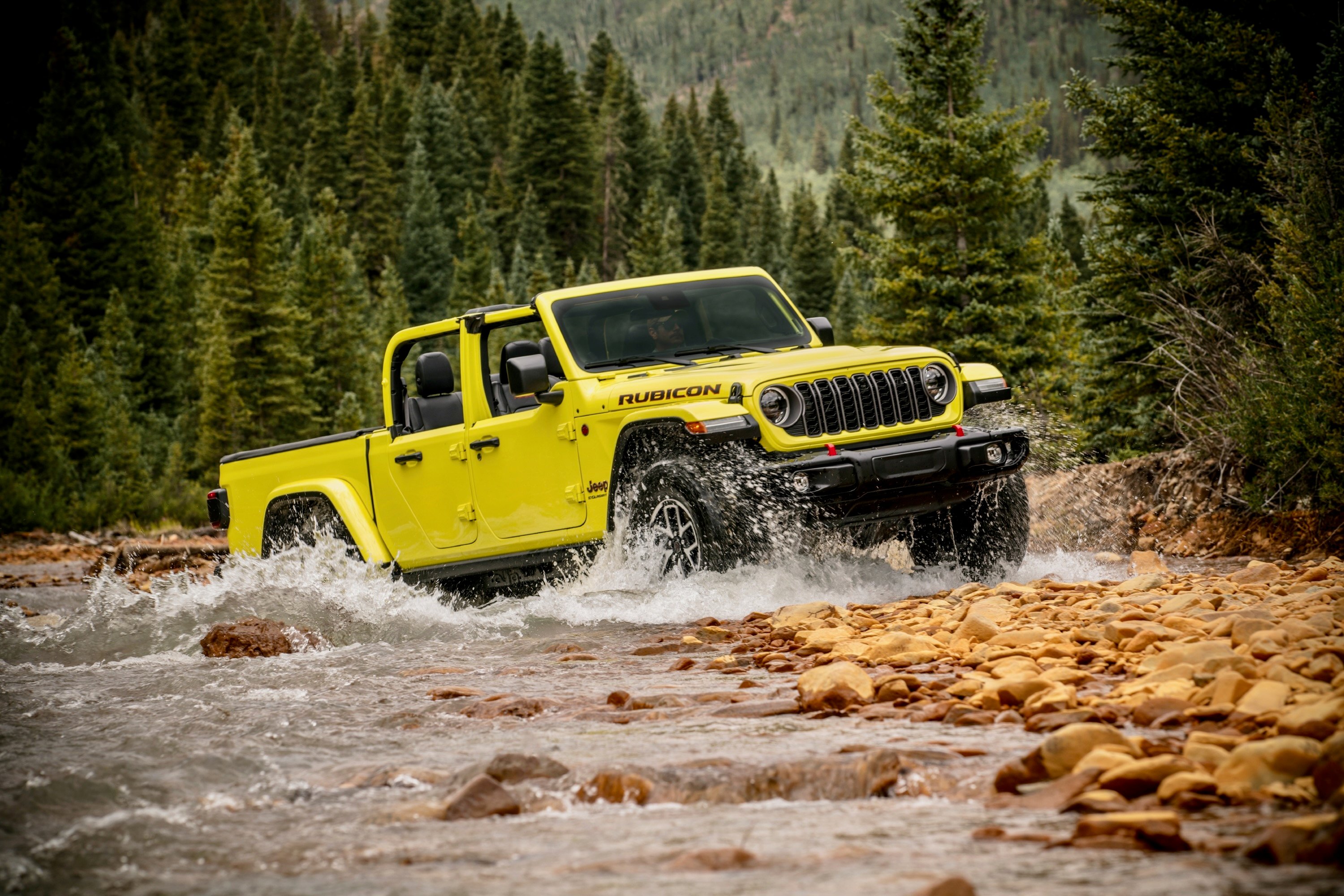
- Price: From $78,250 plus on-road costs (Night Eagle) to $87,250 +ORC (Rubicon)
- Drivetrain/economy/CO2 emissions: 3.6L petrol V6: 209kW/347Nm, 8-speed auto, 4WD, 12.4L/100km, 288g/km
- Dimensions: 5591mm long, 1894mm wide, 1905mm tall, 3488mm long wheelbase
- Towing capacity/GVM/GCM: 2721kg/2880kg/5601kg
- Warranty/roadside assistance/service intervals: Five-year/100,000km, 12 months of roadside assistance with each dealer service (no limit), annual/12,000km
- Five-year service cost: $1995 ($399 per year)
| Driving | |
|---|---|
| Interior | |
| Practicality | |
| Overall value |
Things we like
- Lots of fun touches, like the removable roof
- Excellent off-road ability
- Comfortable to drive
Not so much
- Rivals offer better towing and payload
- No diesel option, just a thirsty NA V6
- Quite expensive
The Jeep Gladiator was originally launched in Australia in 2020 and has received modest sales success since then. Really just a stretched version of the highly capable Wrangler off-roader, the Gladiator is more of a lifestyle product than a lot of the utes on this list – its braked towing capacity is only 2721kg or around 800kg less than most proper ute rivals, for example.
Part of that is that the Gladiator is only available in Australia with a 209kW/347Nm 3.6-litre petrol V6 engine mated to an eight-speed automatic – earlier North American versions were available with a V6 diesel engine that would’ve given it more capability, but alas, that was never offered in Australia. The petrol V6 is powerful, though it lacks torque – something you need when towing.
But the Gladiator has a lot more ‘cool factor’ than most other utes – for example, did you know that it’s actually a convertible? The roof panels are removable for that true wind in your hair off-road feeling. It’s also covered in Jeep ‘Easter eggs’ – small clues to its past – that give it more character than most rivals.
While the engine could be torquier, the on-road experience in the Gladiator is largely comfortable and its off-road ability is one of the best here. Jeep’s five-year/100,000km warranty is shorter than a lot of rivals here, but it does offer roadside assistance for the life of the vehicle if serviced through a Jeep dealer and the first five services cost only $399. Overall, the Jeep Gladiator is more lifestyle toy than serious ute, but those who understand it will love it.
BYD Shark 6
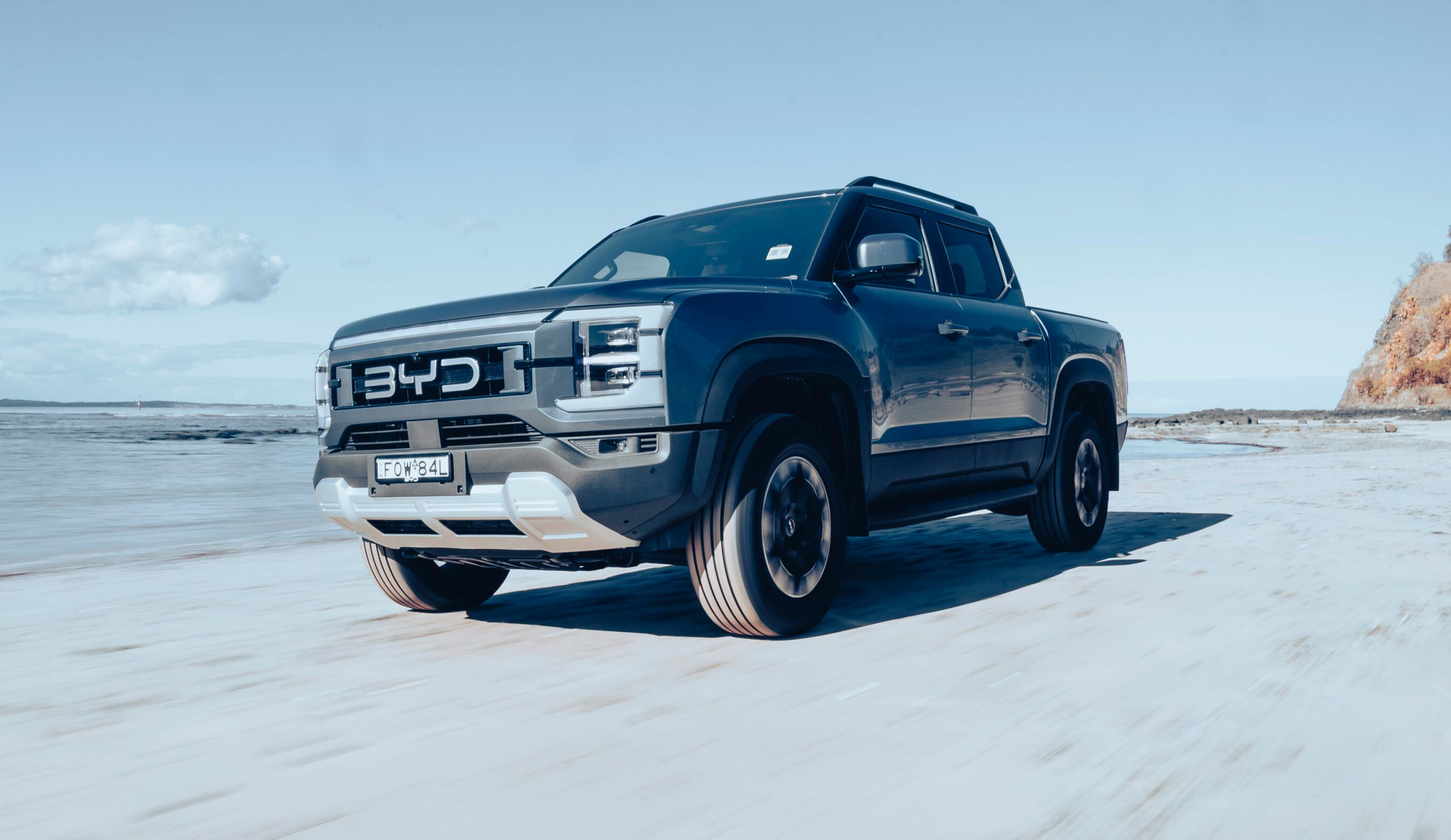
- Price: From $57,800 plus on-road costs (Premium)
- Drivetrain/economy/CO2 emissions: 1.5L turbo-petrol PHEV: 321kW/650Nm, single-speed auto, 4WD, 2.0L/100km, 46g/km
- Dimensions: 5457mm long, 1971mm wide, 1925mm tall, 3260mm long wheelbase
- Towing capacity/GVM/GCM: 2500kg/3500kg/TBC
- Warranty/roadside assistance/service intervals: Six-year/150,000km, eight-year/160,000km battery coverage, 12 months of roadside assistance with each dealer service, annual/20,000km
- Five-year service cost: $2489 ($498 per year)
| Driving | |
|---|---|
| Interior | |
| Practicality | |
| Overall value |
Things we like
- Excellent value for money
- Quick performance
- Feature-loaded and good quality cabin
Not so much
- Not as capable as Ranger PHEV in towing
- Not as capable off-road as rivals
- Thirsty if not charged
The BYD Shark 6 is a disruptor. And like most disruptor technologies, it does a few things extremely well, but it’s never going to be for everyone. We get that. We also understand that there’s a constituency of ute buyers who will never subject their machinery to terrain more arduous than an unsealed road and have no real requirement to tow huge loads. Even Ford’s figures back that up, with a large majority (70 percent) of Ranger owners never logging heavy towing journeys.
If that sounds like you, the Shark may well rack up a big score in the credit column. If you see a ute as something that opens the door to lifestyle activities like cycling, surfing or camping or if you need one to transport work gear around, it probably has you covered in a way that none of its rivals can quite manage.
For a start, it’s a plug-in hybrid that offers around 85km of real-world electric range, against a claim of 100km. And hooey, is it quick out of the blocks. If a Shark pulls up alongside your Raptor don’t start gunning your engine. You’ll only be embarrassed by the Chinese ute’s fierce step-off and left wondering whether the additional $33k you dropped on the Ford was money well spent. It was, don’t worry.
Nevertheless, the Shark keeps the surprises coming, with a polished ride, an interior treatment that’s more mature and well thought-through than we bet you were banking on, a useful and large tray with lighting and a trio of three-pin sockets to power tools, camping gear, e-bikes or other electronic gear. Do keep in mind the modest 790kg payload and the 2500kg braked towing figure though.
The 1.5-litre petrol engine sounds woefully underbaked for a 2710kg vehicle, but it can draw upon a 30kWh blade battery which translates into a punchy system output of 321kW and 650Nm. BYD quotes a 2.0L/100km fuel economy figure, and the Shark can charge at up to 55kW on a DC charger. You’ll get nearer 8L/100km, which is still lineball with many diesel utes.
Sales have been strong, and it’s possible that in 2025, the Shark will depose the Isuzu D-MAX as Australia’s third-favourite ute. That’s an incredible effort coming from a base of zero. Being a disruptor comes with a certain element of risk. Being a very talented one, less so.
Kia Tasman
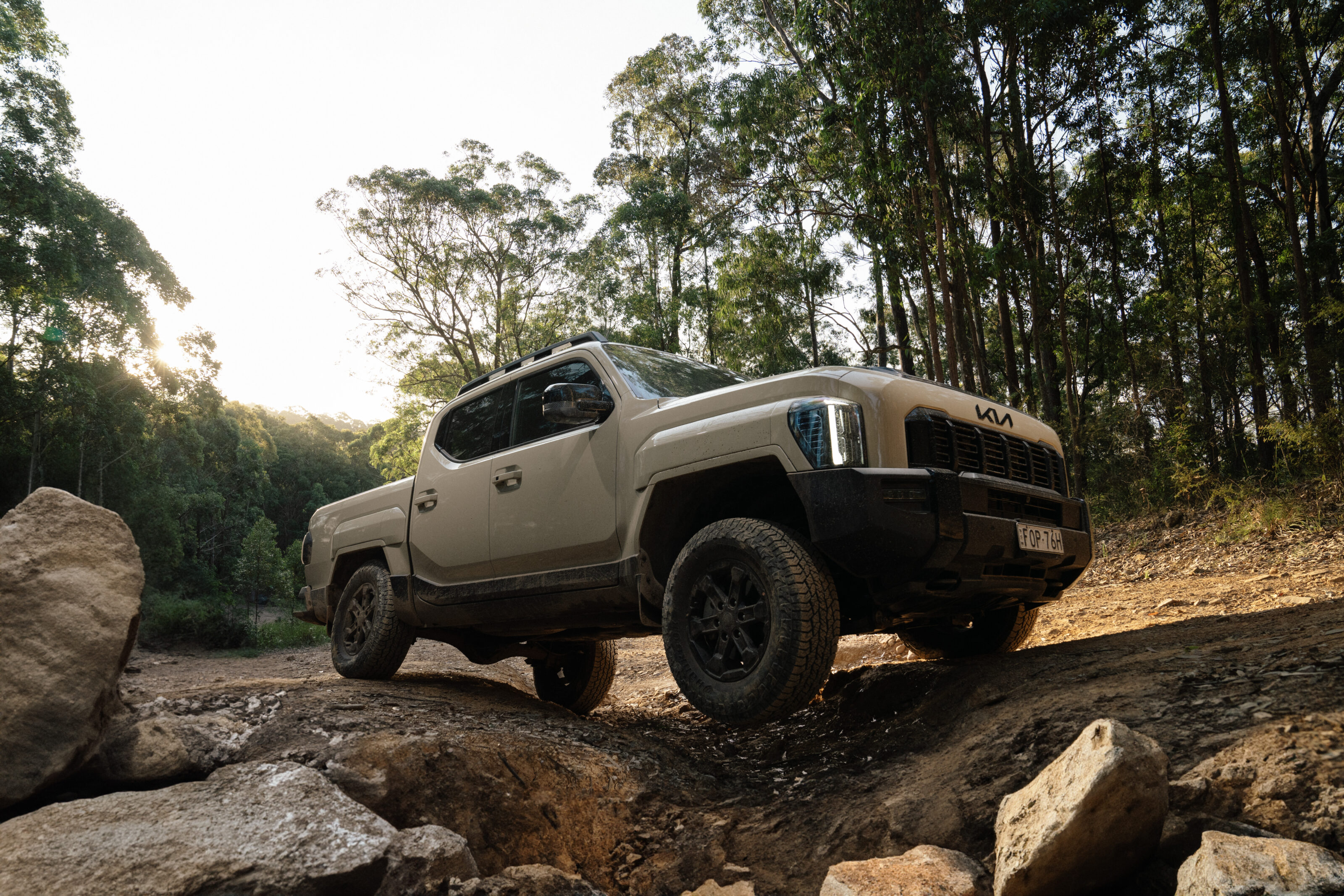
- Price: From $42,990 plus on-road costs (S 4×2) to $74,990 +ORC (X-Pro 4×4)
- Drivetrain/economy/CO2 emissions: 2.2L turbo-diesel: 154kW/440Nm, 8-speed auto, 2WD or 4WD, 7.6L/100km, TBC g/km
- Dimensions: Up to 5410mm long, 1930mm wide, 1920mm tall, 3270mm long wheelbase
- Towing capacity/GVM/GCM: 3500kg/3250kg/6200kg
- Warranty/roadside assistance/service intervals: Seven-year/unlimited km, 12 months of roadside assistance with each dealer service up to eight years in total
- Five-year service cost: $TBC
| Driving | |
|---|---|
| Interior | |
| Practicality | |
| Overall value |
Things we like
- Nice to drive, grunty diesel
- Simple model range
- Intuitive and practical interior
Not so much
- No variant is particularly cheap to buy
- No manual option
- No single cab or hybrid yet
The Kia Tasman is the new kid on the block and made by a brand that’s never entered the ute segment before. Using a distinctively Australian name, the Tasman was largely developed for Australia, so it had better be good. Luckily for Kia, in a lot of respects, it is quite good.
The cabin of the Tasman takes a lot of what we’ve seen from other new Kia models, such as the large dual panel infotainment and driver’s display, handy tabs to adjust the temperature of the cabin and plenty of cabin storage, into a more workman-like layout. Both families and tradies will appreciate the Tasman’s practical details, such as the dual wireless phone charger on some models.
The 2.2-litre turbo-diesel engine in the Tasman is also used in the Sorento SUV and Carnival MPV and it’s one of the most refined in the segment. While its peak 440Nm torque output could be better, its 3500kg braked towing capacity is up there with the leaders in the segment. On the road, the Tasman impresses with its Australian-tuned ride quality, and is more comfortable than most rivals over a variety of surfaces.
Overall, the Kia Tasman is a serious entrant into the ute segment that deserves attention. While some may not like its styling, it could offer more performance and we aren’t yet aware of how much it will cost to service, it’s still a very impressive first time effort from Kia. We expect it to push the brand’s sales further up the leaderboard in Australia. Top three? Time will tell.
Toyota LandCruiser 70 Series
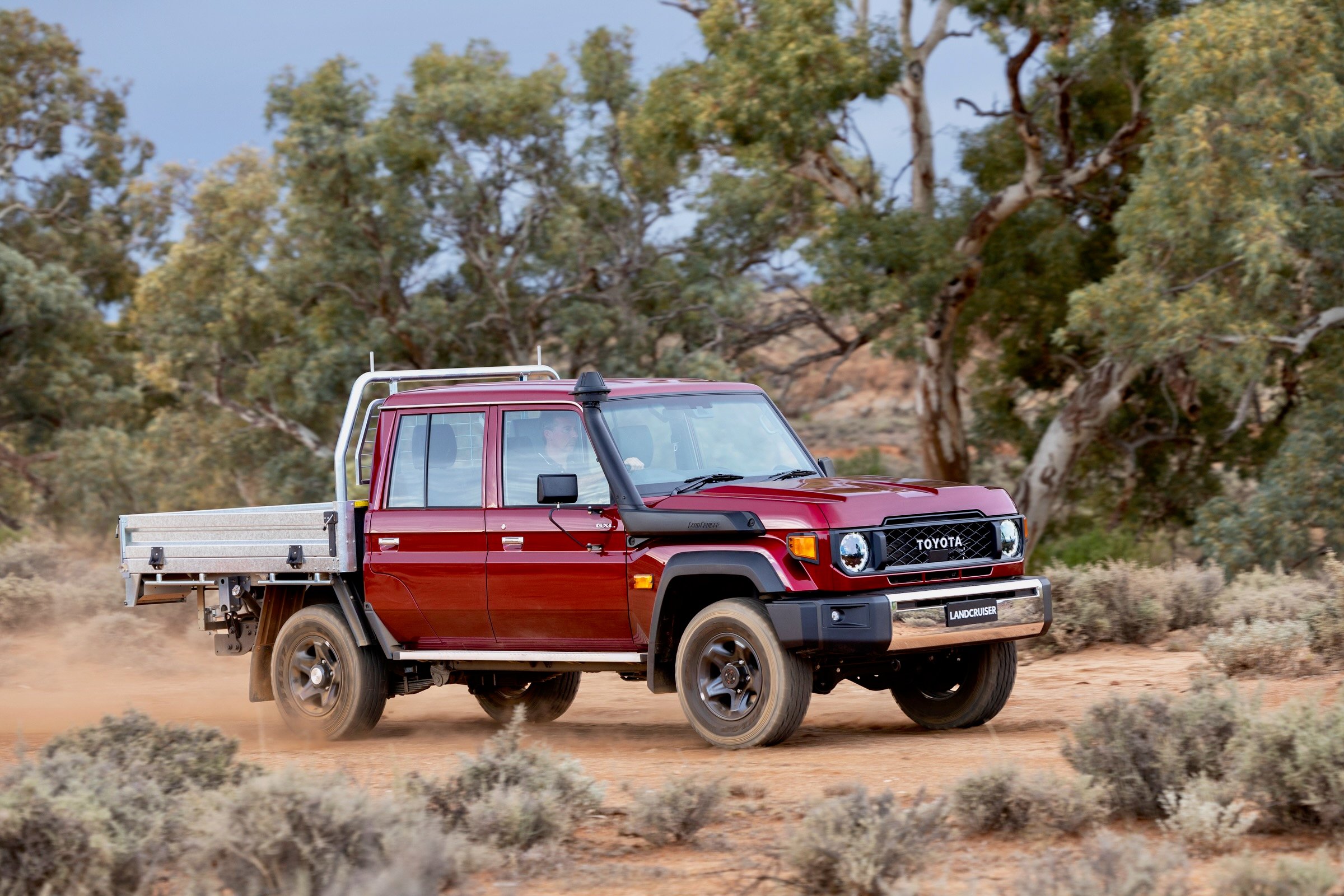
- Price: From $76,800 plus on-road costs (Workmate) to $83,500 +ORC (GXL)
- Drivetrain/economy/CO2 emissions: 2.8L turbo-diesel: 150kW/450-500Nm, five-speed manual or six-speed auto, 4WD, 9.6L/100km, TBC CO2
- Dimensions: 5175mm long, 1820mm wide, 1915mm tall, 3040mm long wheelbase
- Towing capacity/GVM/GCM: 3500kg/3510kg/7010kg
- Warranty/roadside assistance/service intervals: Five-year/unlimited km warranty, no roadside assistance, six-month/10,000km
- Four-year service cost: $5450 ($1090 per year)
| Driving | |
|---|---|
| Interior | |
| Practicality | |
| Overall value |
Things we like
- Punchy 2.8L diesel now standard across the range
- Great off-road ability
- Heavy duty GCM
Not so much
- Expensive to buy and service
- Feels ancient
- Some will miss the former V8
If an award was to be given for the most legendary ute, the Toyota LandCruiser 70 Series would likely be the winner. Production for the 70 Series started in 1984, and while it’s had numerous technological, mechanical and safety updates since then, it’s still the same basic hard-working product that it’s always been.
Recently, the former 4.5-litre V8 turbo-diesel engine that so many buyers loved about the LC70 was shelved and in its place, the 150kW 2.8-litre four-cylinder diesel that is used in products such as the HiLux and a six-speed automatic transmission. While some may lament the V8, there’s no denying that the four actually makes more power and torque, and an automatic transmission will open up its appeal against the former manual-only V8.
Inside the LC70 is a basic and ancient-feeling cabin with very little in the way of comfort – electric mirrors, lumbar adjustment and even automatic climate control aren’t available. A new 7.0-inch touchscreen now features with a very aftermarket look, though it at least has Apple CarPlay and Android Auto to bypass the native system’s lack of functionality. The new digital trip computer has also made it feel more modern than previous versions, though it’s still quite basic.
Like other new Toyota products, the LC70 is covered by a five-year/unlimited km warranty with no roadside assistance. Its servicing is quite expensive as well, and also quite inconvenient at six-month/10,000km intervals. But the expense and old feeling will be easily brushed off by those that the LC70 appeals to. It’s a no-nonsense go anywhere vehicle, now with just a sprinkle of modern tech like LED headlights, smartphone mirroring and – gasp – an automatic transmission.
We recommend
-
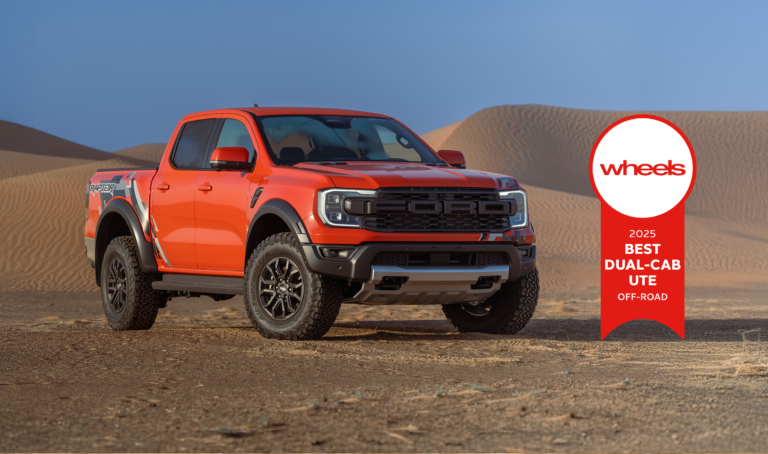 Best Utes
Best UtesBest Dual-Cab Utes 2025: Off-road
For when you need to take the work truck further afield, the winner in Wheels Best Dual-Cab Utes 2025: Off-road...
-
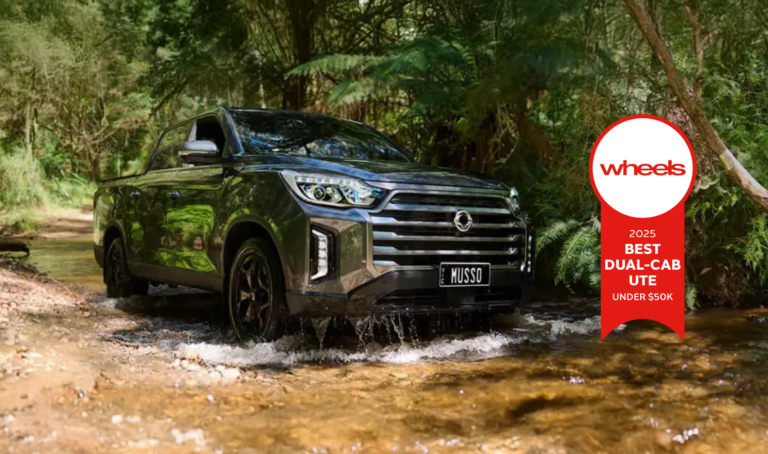 Best Utes
Best UtesBest Dual-Cab Utes 2025: Under $50K
Wheels names its best dual-cab utes on the Australian market for 2025, starting with models priced under $50K.

